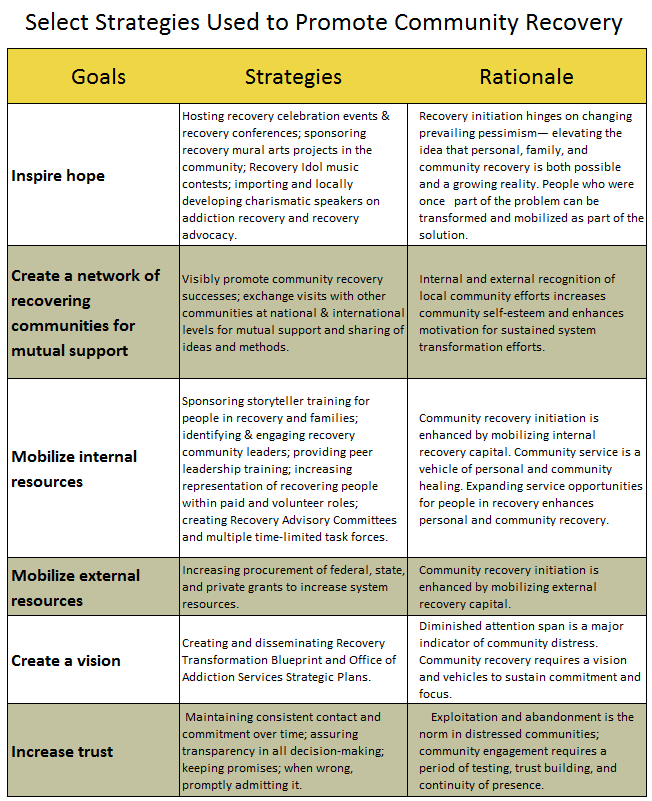The Community as the Patient: How to Promote Community Recovery
Recovery from alcohol and other drug problems has typically been conceived as a personal transformation, but what happens when the substance use problem is community-wide?
WHAT PROBLEM DOES THIS STUDY ADDRESS?
Recovery from alcohol and other drug problems has often been referred to as problem resolution and quality of life improvements that occur on a personal level. Beyond the personal level, widespread problematic use of alcohol and other drugs can deteriorate system level resources such as strong families, tight social networks, and indigenous community institutions. Over time, when hopelessness and learned helplessness become ingrained in community culture and transmitted across generations, the community itself is in need of recovery from alcohol and other drug problems. Little attention has been paid to recovery on a community level; therefore, there is a need to identify strategies used to promote community recovery. The purpose of this article was to draw on the authors’ experiences within a recovery-focused behavioral health care systems transformation to define community recovery and outline some working principles.
HOW WAS THIS STUDY CONDUCTED?
For 5 years the authors were involved in a recovery-focused renovation in the behavioral healthcare system in Philadelphia, PA. They navigated a complex system of personal, family, neighborhood, and community health factors. Although the primary focus was on enhancing recovery outcomes for individuals and families affected by behavioral health disorders, they routinely reexamined the idea of community recovery as both a goal and method. In the process, they identified several strategies that promoted recovery from alcohol and other drugs at multiple levels.
WHAT DID THIS STUDY FIND?
Using a case study, the authors identified the methods most linked to the goal of community recovery in the forms of inspiration of hope, creating a network of recovering communities, mobilizing internal and external resources, creating a vision, and increasing trust.

WHY IS THIS STUDY IMPORTANT
Larger social systems within communities and neighborhoods can be devastated also by the prolonged effects of alcohol and other drugs and ultimately undermine recovery efforts. This article outlines strategies on how social systems can be targeted to support recovery at the community level, which in turn, can foster recovery on the individual level. Community recovery is more than the individual recovery of community members, it involves “strengthening the connective tissue” between people with and without active alcohol and other drug problems, while rebuilding and sustaining the quality of community life. Strategies of community building and rejuvenation (Table 1), can be paired with, or stand as an alternative to clinical models of intervention (click here for a social enterprise model called Jobs, Friends, and Houses), depending on the needs of the community.
- LIMITATIONS
-
- This is a single case study of a behavioral healthcare renovation project. It offers important strategies and reasoning but is not quantified for empirical analyses, thus the reduction in prevalence of alcohol and other drug problems or the uptick in community resources is unknown.
NEXT STEPS
Previous models to intervene in alcohol and other drug problems have used treatment facilities in which trained professionals would screen and treat individuals and families. Future work could conceptualize the community as the patient conducting assessments, making informed diagnoses of the nature of the problems, and mobilize and catalyze recovery processes for the community as a whole.
BOTTOM LINE
- For individuals & families seeking recovery: People in distressed communities need opportunities to share their experiences. Personal recovery from alcohol and other drugs can translate into collective recovery when you can see your story as part of a larger story (i.e., “I” to “we”). Consider engaging in focus groups, town meetings, and other listening forms where people can share their experience, strength, and hope.
- For scientists: This article suggested that a neighborhood, community, or culture can be said to be in need of recovery when alcohol and other drug related problems reach levels of prevalence and severity that threaten collective health and functioning and are transmitted generationally. Conducting recovery prevalence surveys, mapping problem severity by zip code, and establishing recovery-focused system performance benchmarks are all areas that scientists can contribute to that will advance efforts for community recovery.
- For policy makers: In this case study, the authors demonstrated and documented revitalization efforts at the community level to improve recovery from alcohol and other drug problems. There are multiple pathways and styles of community recovery and renewal. Funding a Recovery Community Center or building recovery support into other settings such as schools, churches, businesses, arts, and sports will increase the social space for recovery. Successful strategies for community recovery should achieve good fits at both the community and cultural levels.
- For treatment professionals and treatment systems: As treatment systems start to emphasize recovery and resilience as complementary goals to reductions in pathology, their vision will inevitably identify the inter-connectedness of the individual within a larger ecology and plans of individual recovery will be extended to that of the community. Hosting meetings that mix treatment providers, allied professionals, individuals, family members, and grassroots organizations may help connect service providers and the larger community in ways that are synergistic and mutually beneficial. Creating structured exercises in relationship-building will decrease polarization and us-versus-them mentality (i.e., one group versus the other group).
CITATIONS
Evans, A.C., Lamb, R., & White, W. (2013). The community as the patient: Recovery-focused community mobilization in Philadelphia, PA (USA), 2005-2012. Alcoholism Treatment Quarterly, 31(4), 450-465.

